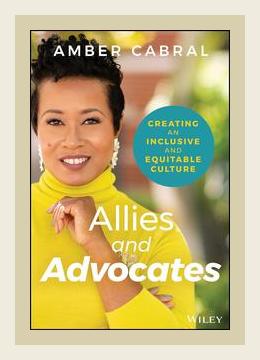Human Resources and Talent ManagementDiversity and Inclusion
**
Introduction
“Allies and Advocates: Creating an Inclusive and Equitable Culture,” written by Amber Cabral in 2020, delves into the intricacies of fostering inclusion and equity within various environments, particularly workplaces. The book serves as a practical guide for individuals who seek to promote diversity and establish supportive spaces. Cabral frames her insights with a mix of theoretical considerations and actionable steps, providing tangible methods to recognize, understand, and combat systemic inequalities.
1. Understanding the Fundamentals of Allyship
Key Point: Allyship is an active, ongoing process of advocating for marginalized groups.
Action Step: Educate yourself continuously about the history and struggles of underrepresented groups.
Example: Cabral emphasizes the importance of self-education without burdening marginalized individuals to teach others about their lived experiences. For instance, one should read books, watch documentaries, and attend events that focus on the experiences of Black, Indigenous, and People of Color (BIPOC).
2. Moving from Awareness to Action
Key Point: Awareness of biases and inequities is essential but insufficient without accompanying actions that address and mitigate these issues.
Action Step: Implement anti-bias training within organizations.
Example: Cabral illustrates that many companies perform routine diversity training but fail to turn these into actionable strategies. To combat this, she suggests adopting comprehensive anti-bias training programs, followed by creating detailed action plans that outline how to apply the lessons learned in everyday organizational processes.
3. Checking Privilege and Using it Positively
Key Point: Recognize your privilege and use it to amplify the voices of those who are marginalized.
Action Step: Use your platform to elevate the perspectives of underrepresented colleagues.
Example: Cabral shares a scenario where a white male executive realizes his privilege allows him to be heard more quickly in meetings. He decides to use this privilege by explicitly endorsing the ideas of his female and minority colleagues, ensuring their contributions receive the recognition they deserve.
4. Building Inclusive Workplaces
Key Point: Inclusion involves everyone feeling welcomed, respected, supported, and valued. It’s not merely about numerical representation but about creating a culture where diversity can thrive.
Action Step: Develop and enforce robust diversity and inclusion policies that involve fair treatment, access, and opportunity.
Example: Cabral discusses a tech company that revamped its hiring practices to ensure a diverse pool of candidates. They instituted a rule where at least one person from an underrepresented group had to be interviewed for each position. Over time, this policy helped shift the company culture by integrating diverse perspectives into everyday operations.
5. The Importance of Advocacy
Key Point: Advocates take their support a step further by using their resources and influence to challenge and change systemic inequalities.
Action Step: Speak out against injustices and inequities, both within and outside the workplace.
Example: The book shares the story of a senior manager who noticed underrepresentation of women in leadership roles. He spearheaded a mentorship program specifically for women, helping to bridge the gap and foster more balanced leadership representation.
6. Microaggressions and Their Impact
Key Point: Microaggressions are daily verbal, behavioral, or environmental slights that, whether intentional or not, communicate hostile or negative attitudes toward marginalized groups.
Action Step: Call out microaggressions when you see them, and educate others about their effects.
Example: In one example, Cabral recounts an incident where a colleague repeatedly mispronounces a peer’s ethnic name. An ally steps in to correct the mispronunciation and educates the team on the importance of respecting individuals’ names, emphasizing how such seemingly small actions can undermine someone’s sense of belonging and legitimacy.
7. The Role of Listening
Key Point: Genuine listening is critical to understanding the experiences and perspectives of marginalized people.
Action Step: Create safe spaces for open and honest dialogue.
Example: Cabral suggests organizing listening sessions where employees from underrepresented groups can share their experiences openly. For example, a company might hold monthly meetings where minority employees discuss their workplace challenges, ensuring these insights are used to shape future company policies and practices.
8. Being Proactive Rather Than Reactive
Key Point: Proactive measures in diversity and inclusion prevent problems rather than merely addressing them after they arise.
Action Step: Regularly review and update policies to ensure they are inclusive and equitable.
Example: Instead of reacting to diversity issues as they appear, a business may institute regular audits of its diversity policies and employee demographics, ensuring that processes remain aligned with the goal of fostering an inclusive environment.
9. Shared Accountability
Key Point: Allies and advocates must hold themselves and others accountable for maintaining an equitable culture.
Action Step: Establish metrics and accountability systems for diversity and inclusion goals.
Example: Cabral describes a company that created a diversity and inclusion task force responsible for tracking the progress of specific inclusion initiatives. This task force developed key performance indicators (KPIs) related to hiring practices, employee retention rates, and diversity in leadership, ensuring that the company remained committed to its inclusion goals.
10. The Power of Empathy
Key Point: Empathy allows us to see the world from someone else’s perspective, fostering deeper connections and a more inclusive environment.
Action Step: Practice active empathy by seeking to understand and validate the emotions and experiences of others.
Example: An employee faced racial discrimination at work, and their colleague, instead of dismissing their feelings, listened attentively, validated their experience, and offered support by accompanying them when they reported the issue to HR.
Conclusion
Amber Cabral’s “Allies and Advocates” is a guide that not only educates about the theoretical underpinnings of diversity and inclusion but also provides practical strategies to implement these principles effectively. By offering concrete examples and actionable steps, Cabral empowers individuals and organizations to create an inclusive and equitable culture that goes beyond tokenism to real, sustained change. Through continuous self-education, active advocacy, empathetic listening, and shared accountability, we can all contribute to a diverse and inclusive society.
Human Resources and Talent ManagementDiversity and Inclusion
